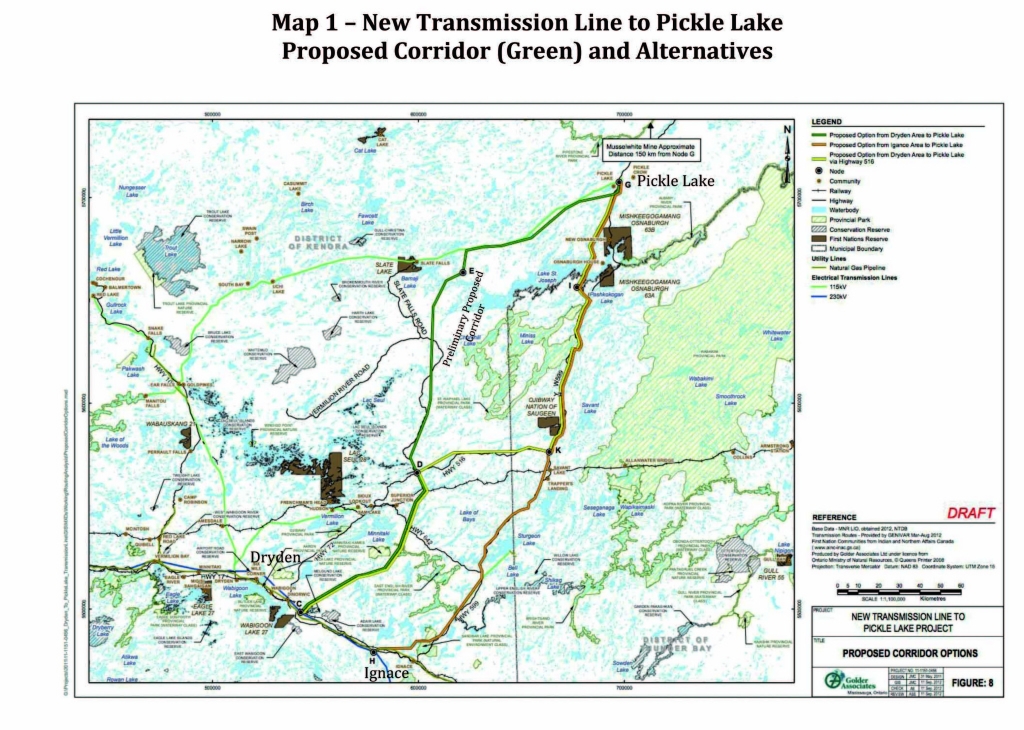In a signing last week that marked another step towards building an electricity transmission line to Pickle Lake and then connecting 10 remote First Nations to the southern electrical grid, 13 northwestern Ontario First Nations joined Goldcorp to officially incorporate Wataynikaneyap Power.
The April 4 announcement comes as pre-development on phase one of the project – a 300 km line to Pickle Lake that will replace an existing, insufficient line – continues and Wataynikaneyap Power works towards starting construction on phase one of the project in 2014.
Margaret Kenequanash, a steering committee member for Wataynikaneyap Power, said the announcement represents the establishment of a formal structure that will facilitate the next steps of the project.
“It’s a huge project, and quite exciting,” Kenequanash said. “Our mandate is to ensure electricity connection to remote communities, to meet the great need for improved energy for the communities.”
Kenequanash noted that many of the communities are at capacity with diesel generators, which limits their ability to build much-needed homes, businesses and other developments.
While 10 communities are targeted for connection as part of the second phase of the project, up to 21 communities could be connected in the future if plans to expand the lines east and west go through.
According to a press release by Wataynikaneyap, Ontario’s 25 remote communities burn approximately 25 million litres of diesel fuel per year to generate electricity. The cost of this diesel generation has been estimated at approximately $68 million annually. In the long term, a new transmission line would cost significantly less than continued diesel generation.
Goldcorp’s involvement in the project has focused on bringing a new electricity line to Pickle Lake, where it could connect to its Musslewhite gold mine. The existing line to Pickle Lake does not have enough capacity for the northern communities. It also is subject to frequent power outages, which disrupt operations at the mine.
“Wataynikaneyap Power is an example of how industry and First Nations can work together on projects that are good for the economy and the environment while benefitting communities in the region for years to come,” said Gil Lawson, manager of Goldcorp’s Musselwhite Mine in a press release.
While the April 4 announcement formalized Goldcorp as a 50-50 partner in the project, the mining company will pull out of the partnership once Wataynikaneyap finds a transmission company to partner with.
Kenequanash said the steering committee will start seeking expressions of interest from transmission companies in the coming months, with a goal of finding a partner by the end of 2013.
She said that throughout the project local communities will have opportunities to create spin off businesses and fill specialized service needs, as well as participate in the construction of the lines which are expected to create about 1,200 jobs.
Kenequanash said the proponents hope to complete phase one construction by the end of 2015, and have phase two construction start in 2017.
In the long run the plan is to have the company be 100 per cent First Nation owned.
First Nations that wish to partner on the project can still do so.
“Now is the time for communities to come on board,” Kenequanash said.
Gold has arrived.










Gold has arrived. Here in the north of Ontario we see vast streams of gold shimmering across the landscape as autumn is here and the the leaves are turning...
I am the product, evolution of many thousands of years as are you. I grew up on the land in the remote far north of Ontario following in the footsteps of my...